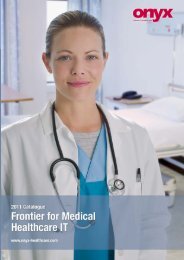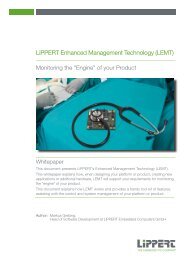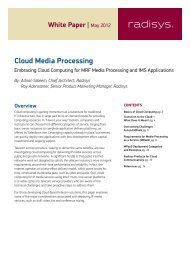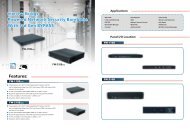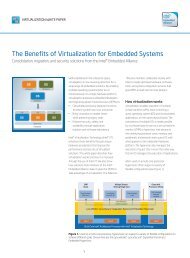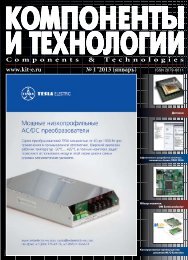Knowledge helps healing - Embedded Community - Intel
Knowledge helps healing - Embedded Community - Intel
Knowledge helps healing - Embedded Community - Intel
You also want an ePaper? Increase the reach of your titles
YUMPU automatically turns print PDFs into web optimized ePapers that Google loves.
CoMpuTeRs<br />
in The hospiTal<br />
people and computers<br />
as a team for ultimate care<br />
ModeRn as TRadiTion<br />
ground-breaking<br />
technologies<br />
hospiTal in-RooM<br />
TRends<br />
The emergence of patient<br />
infotainment | 6<br />
the Digital Healthcare journal<br />
<strong>Knowledge</strong><br />
<strong>helps</strong> <strong>healing</strong><br />
How patients benefit<br />
from data exchange<br />
of devices<br />
ConneCTed hospiTal<br />
1 st i 2011<br />
Computing everywhere at point-of-care<br />
in hospitals | 10
Published by<br />
Advantech Co. Ltd<br />
Address<br />
No. 1, Alley 20,<br />
Lane 26,<br />
Rueiguang Road<br />
Neihu District, Taipei,<br />
Taiwan 114<br />
Tel +886-2-2792-7818<br />
www.advantech.com<br />
ConTenTs<br />
Toll Free Advantech Europe<br />
00800-2426-8080<br />
Email<br />
customercare@advantech.eu<br />
Editorial committee<br />
Joyce Chou,<br />
Tammy Chiu,<br />
Tiffany Chou,<br />
Mariëtte Dusseldorp,<br />
Reinier Middel,<br />
Richard Ponce<br />
Editorial support<br />
Frauke Frerichs-Waldmann<br />
makomti<br />
www.makomti.de<br />
Graphic support<br />
Frank Wolf<br />
WOLFWORK<br />
www.wolfwork.de<br />
All rights reserved.<br />
Reproduction without<br />
permission is strictly<br />
prohibited.<br />
Cover Stories<br />
Interview<br />
Eco Partner Speaks<br />
Viewpoint<br />
News<br />
Country Focus<br />
Features & Benefits<br />
Introduction 3<br />
<strong>Knowledge</strong> <strong>helps</strong> <strong>healing</strong><br />
How patients benefit from data<br />
exchange between devices 4<br />
The eMeRgenCe of paTienT infoTainMenT<br />
Trends in bedside education and<br />
entertainment systems 6<br />
CoMpuTeRs in The hospiTal<br />
People and computers<br />
as a team for ultimate care 8<br />
CoMpuTing eveRywheRe aT poinT-of-CaRe in hospiTals<br />
Computing technologies helping to remove<br />
boundaries, increase efficiencies and improve<br />
the quality of care for all patients 10<br />
ModeRn as TRadiTion<br />
Ground-breaking technologies 12<br />
alphaTRon and advanTeCh TeaM<br />
TeaM up To develop innovaTive CaResTaTion<br />
AMiS – Advanced Mobile intelligent CareStation<br />
will be launched at Medica – Düsseldorf<br />
this November 16th - 19th, 2011 14<br />
auToMaTed anesThesia ReCoRd sysTeM 16<br />
pRoduCT news 18<br />
advanTeCh MediCal CoMpuTing<br />
enables digiTal healThCaRe<br />
With 28 years of IT experience in the embedded<br />
computer industry, Advantech has successfully led<br />
the way with its ePlatform Services and grown into a<br />
leading company in the field. In the healthcare sector,<br />
Advantech has continuously worked with international<br />
medical equipment manufacturers and system integrators,<br />
building a core competency in Advantech’s Medical<br />
Computing Division to aid hospitals in creating patientcentered<br />
healthcare environments and universal digital<br />
healthcare platforms.<br />
In recent years, the world’s major hospitals have<br />
committed to improving their service quality and<br />
efficiency. Advantech has actively developed medical<br />
application platforms in support of this commitment<br />
so that hospitals might integrate their resources and<br />
enhance the overall quality of their services. Advantech<br />
offers medical-grade computers that meet the goal of<br />
providing real-time care in intensive care units and<br />
operating rooms, and it has also developed a series of<br />
mobile healthcare platforms to elevate the quality of<br />
healthcare processes and reduce medical negligence.<br />
Currently, “Advantech Digital Healthcare” has assisted<br />
many hospitals in implementing comprehensive<br />
hospital information systems that provide complete,<br />
real-time medical information. Through Advantech’s<br />
help, hospital staff can make quicker and more accurate<br />
clinical decisions, as well as gain more time to treat and<br />
care for patients.<br />
feedback questionnaire<br />
introduction<br />
In order to facilitate the huge task hospitals face in<br />
integrating medical information systems and embedded<br />
computer technology, Advantech has created the<br />
medAdvantech Journal, a digital information exchange<br />
platform for the healthcare industry. Its aim is to report<br />
on the important trends in medical technology R&D<br />
and application development. The journal will showcase<br />
experts as they explore the latest in regulations and<br />
technology development, and it will make Advantech’s<br />
application case stories available to you. Through this<br />
platform, Advantech would like to share and learn<br />
with our partners, advance the industrial development<br />
of medical computing, and move medical care toward<br />
a patient-centered, digital medical environment. As<br />
part of our mission to “Enable an <strong>Intel</strong>ligent Planet,”<br />
Advantech will promote the intelligent upgrade of<br />
technology in various industries based on our core<br />
competencies in embedded computer design and our<br />
vision of an Internet of Things (IoT) era. As we move<br />
forward, Advantech will continue to focus on the<br />
medical field and will be a key player in promoting the<br />
digital healthcare industry.<br />
1 st 2 1 issue 2011 3<br />
st issue 2011<br />
KC Liu<br />
CEO, Advantech<br />
We would like to receive your valuable feedback about our first issue<br />
of medAdvantech by inviting you to taking part in a brief questionnaire.<br />
Please visit: http://www.advantech.eu/it/MedAdvantechMagazine.<br />
It will only take 2 minutes of your time.<br />
Smartphone users can use the QR code (to the right):<br />
Thank you in advance for your collaboration.<br />
MedAdvantech Editorial committee
Cover story<br />
<strong>Knowledge</strong> <strong>helps</strong> <strong>healing</strong><br />
How patients benefit from data exchange between devices<br />
diagnoses, previous treatments, blood pressure, temperature, examination and analysis results, allergies,<br />
medications - the clinical patient report contains all significant patient data. It provides a picture of a<br />
patient‘s condition and assists doctors and nurses in taking the correct actions quickly. But how does the<br />
data reach the patient report?<br />
More time for patients<br />
“The patient is near and dear to us, we want to concentrate<br />
our time on caring for him. Every minute spent on<br />
paperwork is lost for medical attendance,” explained<br />
Jörg Reis, a certified nurse at the National Institute for<br />
Heart Surgery and Interventional Cardiology (INCCI).<br />
Helping the patient to return to good health is the bright<br />
side of the <strong>healing</strong> professions. The unpopular clerical<br />
work associated especially with the paper version of the<br />
patient record is very time consuming.<br />
The electronic patient record<br />
It is silent in the large room, the light is bright but<br />
pleasantly warm. The large monitor glows dimly next to<br />
the bed. “The monitor provides all important information<br />
concerning the person lying here in the intensive care<br />
unit,” explained Reis. Medical equipment is constantly<br />
becoming more intelligent. Compact computers are also<br />
available, which are developed and built especially for the<br />
medical environment. It was therefore an obvious step<br />
to let the computers and equipment communicate with<br />
each other — the birth of the electronic patient record.<br />
The clerical and administrative effort for all inpatient<br />
and outpatient treatments is reduced drastically by this<br />
central information base.<br />
Good experience at INCCI<br />
INCCI backed modern software and electronics early,<br />
and networked them systematically with each other.<br />
Electronic records were still a purely patient admini-<br />
stration tool back in 2001. By 2009, clinical records had<br />
reached the operating theater, the wards and finally the<br />
catheter laboratory. The cardiological image archiving<br />
and communications system was added in 2010. In<br />
the meantime, all hospitals in Luxemburg and their<br />
cardiologists have access to the digital patient archive. The<br />
archive complies with the strict directives of the European<br />
data protection act. Access rights protect sensitive data,<br />
restricting delivery to authorized caregivers. “Our team<br />
has accepted the new technology very well. The terminals<br />
are now a valuable element of our everyday nursing,” says<br />
Reis.<br />
All information in the right place<br />
The benefit for the patient is great, because data is available<br />
exactly at the point where it is needed, thanks to the<br />
electronic patient record. The information accompanies<br />
the patients from the operating theater to the ward bed.<br />
“All of our intensive care beds have a dedicated terminal,<br />
from which the patient’s data can be called up. This<br />
ensures the greatest possible security for the patient,”<br />
explained Reis. The computer logs the procedures of<br />
the cardiopulmonary bypass or other intensive medical<br />
equipment, just like an efficient secretary, and converts<br />
the multitude of numbers into illustrative curves.<br />
Interrelationships can then be identified at a glance.<br />
Male nurse Ludovic Loret<br />
at INCCI intensive care<br />
This simplifies making correct decisions. “The more<br />
information available, the better help can be given. It<br />
happens faster and is more reliable than the old paper<br />
record,” explained Reis.<br />
The technology<br />
The monitors with embedded computers, so-called<br />
point-of-care terminals are built specifically for the<br />
medical environment. Their surfaces can easily be<br />
Jörg Reis is a certified male nurse and IT specialist for<br />
application development. He works for INCCI, the<br />
National Institute for Heart Surgery and Interventional<br />
Cardiology in Luxemburg, and ensures that technology<br />
and software related to the electronic patient record<br />
functions smoothly.<br />
National Institute for Heart Surgery<br />
and Interventional Cardiology INCCI<br />
Three surgeons, eleven cardiologists, four anesthesia<br />
specialists, and intensive care work go on at INCCI.<br />
A total of 90 people provide 24-hour full medical<br />
care. The heart surgery department has two operating<br />
theaters, four intensive care beds, four middle care<br />
beds and seven beds for normal medical care. Two<br />
theaters are available in the interventional cardiology<br />
department for heart catheter examinations. Since its<br />
opening in June 2001, the department for anesthesia<br />
and intensive care has treated more than 500 heart<br />
patients.<br />
kept sterile. The devices are quiet and clean, since they<br />
function without ventilation fans. As a result, they are<br />
also used in the operating theater to assist the anesthetist.<br />
The terminals operate 24 hours per day and are replaced<br />
by the next generation after approximately four years.<br />
INCCI has just installed the new generation point-ofcare<br />
terminals (POC) from Advantech. “We decided to<br />
buy the Advantech POC, because the technology, price<br />
and support are right for us. I can buy the equipment<br />
with or without touchscreen, with professional support<br />
at my side, offered by Advantech’s integration partner<br />
Megabyte Systemhaus, who I can rely on to give me good<br />
support,” commented Reis.<br />
1 st 4 1 issue 2011 5<br />
st issue 2011
Cover story<br />
The eMeRgenCe of paTienT infoTainMenT<br />
Timely communication, good information and plenty of rest, are keys to reducing patient anxiety and building<br />
an environment where medicine and treatment plans can effectively run their course. Technology can<br />
assist medical staff helping them deliver the best care possible; it can also provide information and entertainment<br />
to patients, helping them feel more comfortable. Patient Infotainment terminals are increasingly<br />
popular in hospitals, where they serve the needs of both staff and patient, right from the bedside.<br />
Trends in patient education<br />
and entertainment systems<br />
Today’s hospitals and clinics are undergoing a<br />
transformation. Doctors and nurses still make the<br />
rounds, but thanks to modern technology, they have<br />
access to real-time data virtually anywhere and at any<br />
time. Communication between doctor and patient<br />
is improving by using bedside terminals to augment<br />
diagnosis and treatment discussions. Connected to<br />
hospital information systems (HIS), they can serve up<br />
x-rays, high resolution images, medical history, and<br />
other information that can assist doctors in patient<br />
consultation and treatment. Internet connectivity allows<br />
the hospital to consult with family members who may<br />
be remotely located, using Voice over IP technologies.<br />
Communication is efficient and focused.<br />
Patients can also make use of services from infotainment<br />
terminals. Surfing the web, listening to music or video on<br />
demand, calling friends and family via Skype—these are<br />
all possibilities. But the patient can also access medical<br />
information provided by the hospital, send alerts to<br />
nurses and staff, transact banking, even do work from<br />
the hospital depending on their medical condition.<br />
These trends are keeping patients happier, giving them<br />
pertinent information regarding their health, and easing<br />
anxiety by allowing them to feel more in control.<br />
Hospitals may monetize some offerings to create revenue<br />
streams that can be re-invested in medical care. People<br />
are accustomed to pay-for-use services. This could easily<br />
be applied to media on demand, internet access and<br />
the like. Advertisement revenue is another possibility.<br />
A maternity ward could allow key suppliers of newborn<br />
products to advertise on infotainment displays in postdelivery<br />
care, even providing shopping links via the web.<br />
New versus existing facility<br />
A new facility can pre-cable for its computer technology,<br />
adding network and power drops to patient rooms<br />
and building a wireless infrastructure with adequate<br />
coverage. Infotainment terminals can be planned in the<br />
room design, and cables to terminals can be hidden in<br />
trays in the retractable arms.<br />
The design must be flexible so that regular technology<br />
modifications during install are quick and simple<br />
to make. This includes cable and termination types,<br />
location of end devices or changes to system features.<br />
An existing facility can replace TV sets, and choose<br />
lightweight terminals that are easily placed on table<br />
tops or mounted on walls in patient rooms. System<br />
selection might be affected by available space and<br />
infrastructure. For example, screen size could be limited<br />
by space constraints or weight restrictions on mounting<br />
hardware. Some solutions might include mounting the<br />
screen on a swivel arm at the bedside, table or on the<br />
wall. Such a system would require detailed coordination<br />
with other bedside devices as well as confirmation of the<br />
availability of power and data outlet locations on the<br />
patient room headwall.<br />
Many patient education and entertainment access<br />
systems are moving toward IP-based solutions requiring<br />
UTP. It is therefore is necessary to review existing coaxial<br />
systems to consider upgrading them as needed.<br />
Infotainment terminals at bedside<br />
The St. Olav and New Ahus hospitals in Norway have<br />
completed their goal of placing “a terminal next to every<br />
bed.” The patient infotainment solution delivers TV<br />
and radio on demand, as well as providing a nurse call<br />
application.<br />
At Ireland’s National Maternity Hospital, seven<br />
maternity and postnatal care rooms have installed<br />
patient infotainment terminals to help new moms and<br />
dads educate themselves in how to take care of newborn<br />
babies. New moms can watch videos to learn about<br />
things such as bathing their babies, breastfeeding, tips<br />
for easing postnatal discomfort, and the correct way to<br />
use car seats.<br />
The private-sector Hong Kong Sanatorium & Hospital<br />
uses Advantech terminals as a differentiator and to fulfill<br />
its motto of “Quality in Service, Excellence in Care.”<br />
The devices enhance medical treatment, minimize<br />
errors, and positively identify medical staff and their<br />
patients.<br />
Advantech is proud to have contributed to these<br />
applications. We have been delivering medical<br />
computing solutions for over a decade working with the<br />
top ten solution providers in the medical computing<br />
indus-try. Quality, industrial design, longevity support<br />
and complete customization services are offered by the<br />
AdvantechCare service team. The patient infotainment<br />
products from Advantech have touchscreens, remote<br />
control, RFID, Smart cards and digital TV tuners. The<br />
anti-bacterial enclosures are easy to clean and disinfect.<br />
Mounting solutions are flexible and the devices are<br />
silent in operation with low heat dissipation. Last but<br />
not least, the infotainment terminals are cost-effective,<br />
durable and have UL60601-1/EN60601-1 and IPX1/<br />
IP65/NEMA4 certifications. They run both Windows®<br />
and Android operating systems in a dual configuration,<br />
making it possible to extend mobile device applications<br />
to service-oriented interactive terminals. In the future,<br />
there will be even more convergence with seamless<br />
applications among different intelligent platforms,<br />
allowing people to access information wherever they<br />
may be.<br />
Further integration<br />
Patient infotainment terminal solutions don’t stop<br />
at the bedside. They can be integrated with other<br />
systems in the hospital to create intelligent solutions<br />
throughout the facility, such as scheduling systems,<br />
signage information displays, and connected ancillary<br />
businesses (beauty salon, pharmacy, convenience store,<br />
food services). They can even use network technologies<br />
to extend the reach of a doctor to remote locations<br />
providing tele-health care and personal healthcare<br />
management choices.<br />
1 st 6 1 issue 2011 7<br />
st issue 2011
interview<br />
CoMpuTeRs in The hospiTal<br />
people and computers as a team for ultimate care<br />
what do people expect from a hospital when they become ill? Certainly a wish for tender care, understanding<br />
staff, competent medical support, safe medication and the greatest degree of hygiene. Overall, they expect<br />
the highest quality possible. Nurses and doctors provide tender care. Specialists contribute their competence<br />
and experience. Decisions are based on knowledge. Computers assist the team by making pertinent data<br />
readily accessible to ensure medical staff makes the most informed decisions possible.<br />
Do medical PCs facilitate the work<br />
of nursing staff<br />
This question is difficult to answer as measurable<br />
criteria and reference data is generally not available.<br />
Before and after statistics are not normally recorded.<br />
The one thing that is certain is that use of point-of-care<br />
terminals has changed hospital work. A large amount of<br />
paper work has been eliminated, and with it errors have<br />
been reduced. At the same time, other work has taken its<br />
place, brought on by the implementation of computer<br />
technology.<br />
How does the patient benefit from<br />
the use of point-of-care terminals<br />
Safety of medical care is increased by the use of<br />
POC terminals. Careless mistakes during the<br />
entry of medical records are avoided by the direct<br />
interchange of data between the measuring device and<br />
the PC.<br />
Prompt access to all patient records allows personnel to<br />
perform a focused assessment of current medical state.<br />
Life-support measures can be initiated earlier. Validation<br />
of patient data also ensures safety: Is there a match<br />
between the patient in the bed and the the one on file,<br />
and is the data entered plausible? The medical expertise<br />
of a doctor cannot be replaced by a system, but the<br />
system can be used to augment professional competence<br />
by providing rapid access to reliable data.<br />
What are the<br />
advantages for the hospital<br />
The quality of medical work has become more<br />
transparent, and quality improvement measures<br />
have become possible only by processing patient<br />
data electronically. Comprehensive quality checks,<br />
for example, for organ donations or medication<br />
administration are simplified by electronic data<br />
acquisition. Statis-tical analysis assists in the procedural<br />
improvements. Duration of confinement to bed, state of<br />
the patient when released, and mortality rates are quality<br />
attributes that flow into comparisons of clinics. Medical<br />
verifications to health insurance funds or during court<br />
proceedings can be provided faster and more easily. All<br />
in all, electronic patient data processing can save costs.<br />
The savings potential contributes to cost-efficient clinic<br />
management.<br />
What are the risks and side-effects<br />
The introduction of medical IT systems has<br />
progressed in different ways, from one clinic to<br />
another. Universal standards do not exist and patchwork<br />
and isolated applications can lead to expensive dead ends.<br />
Implementation can be difficult if there is resistance<br />
or lack of experience from IT. At the same time, since<br />
every IT system is continually evolving, there is an<br />
ongoing need for maintenance and care. Normalization,<br />
standardization and uniform quality specifications are<br />
still in their infancy.<br />
Are there any limits<br />
No system in the world will replace medical<br />
competence. But IT can advance medical treatment<br />
and promote innovative ideas. In this way, technology<br />
promotes the recovery of patients, <strong>helps</strong> physicians and<br />
nursing staff in their work, and offers transparency for<br />
insurance companies and hospital operators.<br />
Interview conducted by Frauke Frerichs-Waldmann,<br />
Diplom-Ingenieur, makomti<br />
Dr. Lukas Streit holds a doctorate degree as an intensive<br />
care physician. He works in the intensive care unit at<br />
the Inselspital in Bern. Besides his work as intensive<br />
care physician, he is an active member of the research<br />
team and manages the IT department for the intensive<br />
care unit. Medicine and informatics are equally near<br />
and dear to him.<br />
Inselspital University Hospital Bern<br />
The Inselspital is one of the most eminent university<br />
hospitals in Switzerland; it is a figurehead for the<br />
Canton Bern. It is a medical competence, high-tech<br />
knowledge center with an international reputation.<br />
The staff master the variety of tasks in medicine,<br />
education and research with creativeness, inventive<br />
talent, commitment and perseverance. The patients<br />
are always the center of attention. Humane and<br />
technically outstanding medical and nursing care<br />
of patients is the ultimate ambition of the roughly<br />
7,000 staff members, who care for more than<br />
220,000 patients each year.<br />
1 st 8 1 issue 2011 9<br />
st issue 2011
10<br />
eco partner speaks<br />
CoMpuTing eveRywheRe<br />
aT poinT-of-CaRe in hospiTals<br />
Computing technologies are helping to remove boundaries, increase<br />
efficiencies and improve the quality of care for all patients<br />
The digital healthcare system –<br />
Providing users with the information<br />
they need right at the point-of-care.<br />
Hospitals have changed dramatically over the last several<br />
decades. They have been transformed into sophisticated<br />
medical facilities. Today computer-based medical<br />
equipment is becoming pervasive, and a myriad of<br />
medical equipment such as diagnostic gear, analytical<br />
& laboratory equipment, drug dispensing carts,<br />
computerized physiotherapy, patient infotainment<br />
terminals, multi-parameter patient monitoring, and<br />
endoscopy are all leveraging PC-based architectures.<br />
This new medical landscape is evolving and the drive<br />
towards a connected smart hospital vision (Figure 1)<br />
steadily gains momentum with everything from patient<br />
administration, monitoring and care, imaging and<br />
analysis, and records and health maintenance utilizing<br />
<strong>Intel</strong> architecture based platforms.<br />
Platforms based on <strong>Intel</strong> architecture provide the<br />
performance and high efficiencies needed to make<br />
medical devices more intelligent, more portable and<br />
more connected, making it easier for patients to receive<br />
treatment and more effective for doctors, nurses and<br />
administrators to provide and manage care. <strong>Intel</strong>®,<br />
architecture is at the heart of many of these systems and<br />
as a consequence is helping to enable the connected<br />
smart hospital vision.<br />
Healthcare providers are relying more and more on<br />
computers to access medical data such as electronic<br />
patient records. A good example of this is where<br />
healthcare practitioners are utilizing mobile pointof-care<br />
(MPoC) solutions to improve nurse/doctor<br />
workflows throughout the hospital. By permitting<br />
nurses and doctors to access clinical information systems<br />
at the patient bedside in real-time, MPoC solutions can<br />
facilitate better nurse/doctor workflows. This in turn<br />
has positive impact on patient care and potentially can<br />
reduce the length of hospital stays. Medical Clinical<br />
Assistants (MCA) and other tablet devices are also being<br />
added to the healthcare practitioner toolbox, leading to<br />
the widespread computerization of the hospital and<br />
helping to improve patient treatment.<br />
Medical PCs which are today being deployed and<br />
widely used throughout the hospital from intensive care<br />
units and radiology departments to operating rooms are<br />
another good example of a smart hospital environment.<br />
They are used in a diverse range of medical applications<br />
from data acquisition, vital signs monitoring devices,<br />
Patient Data Management Systems (PDMS) and<br />
visualization (x-ray, endoscopy). Medical PCs play a<br />
critical role in the provision of care by helping to display,<br />
collect and disperse images, and other patient data.<br />
These systems are usually mounted on walls or<br />
ceiling, or on equipment carriers or medication drug<br />
dispensing carts, and they are ideal in helping to<br />
bring EMR, PACS and CPOE to the point-of-care.<br />
There are special regulations governing safety and<br />
emissions for medical computing systems deployed in a<br />
hospital or clinic. Therefore medical platforms must<br />
conform to prevailing medical technology standards<br />
such as UL60601-1 and EN60601-1 in order to ensure<br />
safety and reliability. These systems also typically will<br />
have a touchscreen interface and tend to be fully sealed<br />
in order to ensure that they meet IP65/NEMA 4, and<br />
IPX1 specifications for dust-resistance and water spills.<br />
Medical computing systems are deployed in sterile<br />
areas making it essential that a germ-free environment<br />
be maintained. Therefore, all computing platforms<br />
must be capable of undergoing repeated cleaning<br />
with isopropyl alcohol and other germ-killing agents.<br />
Medical computing systems need to be robust and<br />
reliable and typically have passive cooling systems in<br />
order to remove vents and fans.<br />
For successful integration into a hospital, Medical<br />
PCs must be able to connect to legacy interfaces (like<br />
galvanic-isolated RS-232) which allow connectivity<br />
to more than one medical device. They also need to<br />
support options like Wireless LAN, 10/100/1000BaseT<br />
Ethernet, USB 2.0 and PCI-Card.<br />
<strong>Embedded</strong> platforms based<br />
on <strong>Intel</strong> processors provide<br />
a scalable computer<br />
architecture that meets the<br />
power, performance and<br />
graphics requirements of<br />
the medical market. <strong>Intel</strong>’s<br />
<strong>Embedded</strong> and Communication<br />
Group provides an<br />
embedded roadmap which<br />
ensures the long-term availability<br />
of <strong>Intel</strong>-based platforms<br />
for a period of 7 years,<br />
which is of fundamental<br />
importance for the medical<br />
market segment. The total<br />
computing power required<br />
to run many medical applications<br />
today has increased<br />
many times over and the latest<br />
processors based on second<br />
generation <strong>Intel</strong> Core<br />
microarchitecture offer enhanced<br />
graphics capabilities<br />
and performance (while<br />
reducing overall platform<br />
power requirements) needed<br />
to meet or exceed the<br />
requirements for most medical<br />
applications.<br />
Figure 1:<br />
Connected Smart Hospital Vision<br />
1 st issue 2011<br />
11
viewpoints<br />
ModeRn as TRadiTion<br />
ground-breaking technologies<br />
The bern townswoman anna seiler had a hospital built on november 29th, 1354, to offer free treatment and<br />
care with 13 beds. She wished at that time, that this hospital would exist “for evermore.“ Those 13 beds have<br />
now become 1,100. More than 650 years ago, there were three full-time nurses; in 2011, roughly 7,000 staff<br />
members care for more than 220,000 patients annually. Today, the Inselspital in Bern is a high-tech, medical<br />
competence and knowledge center with an international reputation. The patient is still the focal point, but<br />
computers are moving into all areas of day-to-day clinical work.<br />
Demands on hospitals increase<br />
continuously. Where do you see the<br />
greatest challenges for your area?<br />
The administrative burdens on doctors and nursing staff<br />
increase continuously. A chief physician once described<br />
his situation as follows: His time is spread 50% to his<br />
role as manager and 50% to his administrative activities,<br />
leaving 0% for his medical tasks. We wish to regain more<br />
time for the patients but still be able to fulfill the increased<br />
quality management and verification obligations.<br />
How can computers help in hospitals?<br />
Point-of-care terminals (POC) can be found in day-today<br />
nursing. We monitor vital data of the intensive care<br />
patients at the bedside.<br />
POC terminals record physiologically critical data.<br />
We document services rendered, prescriptions and<br />
administered medications. These records also provide<br />
the data for treatment invoicing, quality assurance and<br />
benchmarking.<br />
Where do you see further application areas<br />
in the intensive care unit?<br />
We have equipped 50 beds with Advantech‘s POC<br />
terminals in a first project. The positive experience<br />
motivates us to also introduce these terminals in the<br />
Anesthesia department. We are currently equipping<br />
our transport beds with Advantech battery operated<br />
POCs. We often travel long distances within our clinic<br />
compound when we transport our patients to other clinic<br />
buildings for special examinations. It takes two or more<br />
hours before the patient is returned to the intensive care<br />
unit. The vital data continues to be monitored with the<br />
mobile POC at the transport beds providing continuous<br />
recording. This ensures greater security for the patients.<br />
What are the trends that you see?<br />
Mobility is increasing. Quality demands are rising.<br />
Changing billing models require more accurate<br />
documentation of the services rendered. Analysis systems<br />
such as benchmarking give transparency, but also need<br />
to be supplied with relevant data. Specialists, specialist<br />
hospitals and finances are limited resources, which do<br />
not keep up with needs. Costs must be reduced, or at<br />
least kept constant.<br />
What do you hope to see<br />
for information technology?<br />
The driving factors for the next hardware generation<br />
will be size, mobility and compatibility. This means,<br />
equipment must be smaller, have a long service life, work<br />
reliably and be connectable to standardized accessories.<br />
The PC must fit in the staff member’s pocket. And it<br />
must, of course, possess a powerful but affordable<br />
rechargeable battery. It would be excellent if accessories<br />
such as bar-code scanners or label printers were already<br />
integrated. Devices should function reliably and have<br />
an appropriately long service life suited for use in a<br />
medical environment. I also would like to see a “medical<br />
cockpitfor” the software, in which access to all data was<br />
intuitive. At present, one must still know which software<br />
package delivers which information.<br />
Where does the future lie in your opinion?<br />
It is conceivable that expert systems will assist with initial<br />
diagnosis. Computer-controlled check-lists will alleviate<br />
stress in the casualty department. Telemedicine will<br />
permit global access to specialists, who will be able to<br />
assist during operations using computerized support<br />
systems. Virtual patients could contribute to safe<br />
treatment, as has been already used successfully in the<br />
pathology area. When in doubt, the computer has the<br />
steadier hand and doesn’t slip with the scalpel. The<br />
processes and procedures in the hospital differ according<br />
to the medical specialization which make a clear case for<br />
a medical cockpit, that is, one software package that can<br />
be configured individually for each clinic.<br />
University clinic for intensive care<br />
medicine at the Inselspital Bern (KIM)<br />
Adult patients at the Inselspital who need intensive<br />
medical care after an accident or surgical operation<br />
are treated here. Specialists work around the clock<br />
to care for patients whose cardiovascular system,<br />
breathing or brain require special attention. An<br />
important milestone was reached in 2010 with the<br />
KommuniKIM project. The project had the goal<br />
to improve and optimize the inter-disciplinary<br />
communication of all patient-relevant information.<br />
1 st 12 1 issue 2011 13<br />
st issue 2011
14<br />
news<br />
alphaTRon and advanTeCh TeaM<br />
up To develop innovaTive CaResTaTion<br />
aMis – advanced Mobile intelligent Carestation will be launched<br />
at Medica – düsseldorf from the 16 th – 19 th of november 2011<br />
Introduction<br />
The idea was born from working closely with caregivers<br />
for many years and listening to their needs. “We<br />
worked with nurses and doctors for many years and<br />
we could see their frustration with mobile computers<br />
because most of the products available in the market<br />
were not designed specifically for them,” says Harald<br />
Verloop, Director of Alphatron Medical Innovations.<br />
To resolve this problem Alphatron entered into a joint<br />
venture with Advantech to develop a nurse’s cart. Both<br />
organizations have worked with caregivers, hospitals<br />
and organizations around the world and understand<br />
that in medical situations quick and adequate solutions<br />
are vital. Professionals increasingly experience stress<br />
because of workload and shortage of personnel, so they<br />
need solutions that make their work more effective.<br />
A2 cooperation<br />
The project was given the name A2 ( Alphatron and<br />
Advantech); the design ideas were developed by<br />
Alphatron with the cooperation of Promea, a Dutch<br />
industrial design company, and the University of Twente.<br />
The aim of the project team was to develop an innovative<br />
solution with an integrated design which included IT<br />
technology, hygienic aspects, ergonomics and safety,<br />
without compromising the needs of the caregivers. To<br />
achieve the objective it was very important to get closer<br />
to the caregivers and listen to their needs. The A2 team<br />
invited some reference hospitals to participate in the<br />
development of the product, and feedback was given by<br />
nurses, doctors, pharmacists and IT staff. The feedback<br />
provided by the caregivers was extremely important in<br />
developing a product specifically suited to them. The<br />
caregivers expressed that they needed a reliable, high<br />
quality product that they could trust without hesitation.<br />
Developers needed to understand the work of medical<br />
providers thoroughly in order to provide the right<br />
solutions and be able to support them technically. The<br />
final engineering and tooling, developed by Alphatron<br />
and Advantech at Advantech headquarters in Taipei,<br />
Taiwan, has led to an effective and intuitive product<br />
that delivers results.<br />
Branding AMiS<br />
“The idea was to develop innovative technologies<br />
in a mobile computer to better address the needs of<br />
healthcare providers and their patients. We designed<br />
the product around the daily routine of nurses, doctors<br />
and other healthcare professionals so we decided to<br />
brand it as AMiS. AMiS is like a friend that stands<br />
by the caregiver no matter what,” says Harald. AMiS<br />
– Advanced Mobile intelligent CareStation is an<br />
integrated mobile computer work cart that has<br />
been developed to optimize<br />
the patient care process.<br />
It also provides wireless access<br />
to patient information. AMiS<br />
is unique because it is<br />
modular, it can be<br />
customized to user needs<br />
and it works intuitively.<br />
1 st issue 2011<br />
15
Country focus<br />
advanTeCh / MedTel bRings new MediCal<br />
TeChnology To Queensland healTh<br />
Winchart is a clinical software solution for perioperative<br />
medicine. The solution is developed and distributed by<br />
Medtel Australia, a subsidiary company of Getz Bros<br />
Ltd. Winchart creator, Peter Toth first began developing<br />
the system in the mid-1990s and is now the production<br />
manager for Medtel’s clinical software division. “In the<br />
mid ‘90s I was working in the anesthesia department<br />
at the (then) Adelaide Children’s Hospital, sharing<br />
an office with Dr David Sainsbury, who (apart from<br />
anesthetizing) was collecting data from the patient<br />
monitoring devices in theater and storing that data on<br />
mobile computer carts,” Toth says. “We had the idea of<br />
creating a software tool to arrange this data graphically<br />
and allow anesthetists to enter drugs, fluids and notes<br />
etc, and so the first Winchart anesthesia record was<br />
born.”<br />
In 2008 Queensland Health gave the go-ahead for the roll<br />
out of Medtel’s Winchart clinical information system,<br />
making it one of the largest integrated hospital health<br />
ICT projects in the country. Queensland Health will<br />
use the system in all phases of perioperative medicine.<br />
When complete, over 500 units, running on Advantech’s<br />
POC-S157 point-of-care terminals, will be deployed<br />
throughout the state’s thirty-two public hospitals.<br />
The partnership between Advantech and Medtel is<br />
nothing new to the Australian health care market.<br />
In fact, this latest joint deployment represents the<br />
fourth generation of specialized medical equipment<br />
implemented by the duo in a steadfast partnership of<br />
over eight years. A long lasting partnership, coupled with<br />
an operational history of reliable, medically-certified<br />
hardware, and running software specially developed by<br />
medical professionals, is arguably the most important<br />
success factor in the project.<br />
The Winchart modules are :<br />
Bookings<br />
PreOp Clinic<br />
IntraOp<br />
PACU<br />
SICU (Surgical Intensive Care)<br />
Acute Pain Service (APS)<br />
Clinical Analysis and Reporting (CARM)<br />
Timeline<br />
Winchart Interface Engine<br />
Winchart is designed to capture clinical information<br />
from patient monitoring equipment and peripheral<br />
medical devices. It is also comprised of a customizable<br />
database allowing for clinicians to enter data with<br />
ease. The product has multiple interfaces to external<br />
systems and applications. Winchart produces a series of<br />
electronic patient records in the acute care environment.<br />
These records can be printed at the point-of-care<br />
and stored in patient notes as well as being archived<br />
to a timeline repository. The records are stored in a<br />
centralized database allowing for easy extraction (via the<br />
CARM module) of clinical reports for audit, research<br />
and hospital management. Its ease of use saves time in<br />
administration which is ultimately given back to patients<br />
in quality care.<br />
Advantech’s POC-S157 point-of-care terminal is wellsuited<br />
to the needs of the Queensland medical computing<br />
environment. The hospital demands for a device that<br />
is slim, easy to maintain, cleanable with antiseptics,<br />
and certified for a medical environment, are easily<br />
met by POC-S157, with its UL60601-1/EN60601-<br />
1 certifications for electrically isolated equipment, an<br />
IPX1 water resistant enclosure and IP65 dust-tight front<br />
panel, and a large 15” color TFT LCD panel which is<br />
equipped with an intuitive touchscreen. The POC-S157<br />
is a highly-integrated, multimedia, <strong>Intel</strong>® Core2 Duo<br />
processor-based mobile computer with a single DVIport,<br />
dual onboard 10/100/1000 PCI-E Ethernet<br />
controllers, a COM port, quad USB 2.0 ports, a 24-bit<br />
stereo audio controller, and built-in 2.5” hard drive, that<br />
is compact and silent in operation.<br />
This is a fourth generation Advantech / Medtel solution,<br />
and Queensland Health’s go ahead is a tribute to the<br />
success of a strong partnership and confidence in the<br />
system’s reliability. Some reports estimate savings of as<br />
much as 90% in staff time over previous, paper-based<br />
systems.<br />
Winchart improves patient care, aids efficiency, provides<br />
consistency and legibility in reports; acts as a data<br />
analysis tool for research and budgeting; and improves<br />
overall risk management by providing data for analysis,<br />
decision making and education to the clinician’s right at<br />
bedside.<br />
1 st 16 1 issue 2011 17<br />
st issue 2011
18<br />
Features & Benefits<br />
pRoduCT news<br />
22” Wide Screen Fanless<br />
Point-of-Care Terminal<br />
The POC-227 Point-of-Care terminal is a fanless system<br />
running an <strong>Intel</strong>® Core2 Duo processor with an <strong>Intel</strong>®<br />
GS45 Express chipset, a 22” WSXGA TFT LCD display,<br />
and capable of high speed computing power. It can be<br />
connected with dual-gigabit connectors and configured<br />
for LAN teaming, or it can use the optional 802.11b/g/n<br />
wireless adapter with up to 300 Mbps of throughput.<br />
POC-227G features a rich selection of USB and isolated<br />
COM-port connectors, and user-friendly function keys.<br />
HIT-W181: Slim 18.5” Fanless Healthcare<br />
Infotainment Terminal<br />
HIT-W181 is an extremely lightweight and slimlydesigned,<br />
18.5” multi-function infotainment terminal.<br />
It comes with touchscreen, WiFi, RFID, a handset, smart<br />
card reader and a two megapixel camera. HIT-W181 can<br />
provide patients with various entertainment programs<br />
such as TV, movies or computer games. Patients can<br />
easily communicate with families via the internet.<br />
Identification recognition for both hospital staff and<br />
patients is possible with the RFID and smart card reader.<br />
advantech Contact details<br />
news flash<br />
advantech at Medica 2011<br />
Toll Free Number: 00 800 24 26 80 80 (English, German)<br />
French, Italian and Spanish: +39 02 95449602<br />
Eastern Europe (English, Polish): +48 22 33 23 740<br />
The Advantech Digital Healthcare team invites you to meet us<br />
at MEDICA-2011, which will be held from November 16th –<br />
19th, 2011, in the Messe Düsseldorf, Germany. Hall 15, Booth<br />
B43<br />
For product information, pricing and support: E-Mail to customercare@advantech.eu<br />
i<br />
The Fast Way to Get Windows <strong>Embedded</strong><br />
Applications to Market<br />
Advantech has been recognized by Microsoft as an <strong>Embedded</strong> Gold Partner, worldwide.<br />
We provide MIcrosoft Windows <strong>Embedded</strong> products individually or integrated with<br />
Advantech embedded solutions.<br />
MS-DOS 6.22<br />
Windows 2000 Professional<br />
Windows XP Professional<br />
Windows Vista Business/Ultimate<br />
Windows 7 Professional/Ultimate<br />
<strong>Embedded</strong> OS<br />
www.advantech.com<br />
Windows <strong>Embedded</strong> Compact<br />
Windows <strong>Embedded</strong> Standard<br />
Windows <strong>Embedded</strong> POSReady<br />
Windows Server<br />
SQL Server<br />
Windows Storage Server<br />
ISA Server<br />
Windows Home Server
feedback questionnaire<br />
We would like to receive your valuable feedback about our first issue of<br />
medAdvantech by inviting you to taking part in a brief questionnaire.<br />
Please visit: http://www.advantech.eu/it/MedAdvantechJournal.<br />
It will only take 2 minutes of your time.<br />
Smartphone users can use the QR code (to the right):<br />
Thank you in advance for your collaboration.<br />
MedAdvantech Editorial committee<br />
Digital Healthcare<br />
Ensuring a Patient-centered Environment<br />
Technology-Enabled Patient Care Ensures Service Quality<br />
Inspired by people-first technologies, Advantech’s revolutionary medical care<br />
solutions enable patient-centric technologies that produce more convenient,<br />
digitally-enhanced healthcare services.<br />
Many medical institutions around the world have benefited from Advantech’s<br />
Digital Healthcare solutions offering patients robust and instantaneous<br />
information solutions that ensure precise, clinical decision-making and<br />
facilitate quality care. These solutions effectively upgrade the quality of care<br />
and safety, and overall medical treatment satisfaction.<br />
2000019088



